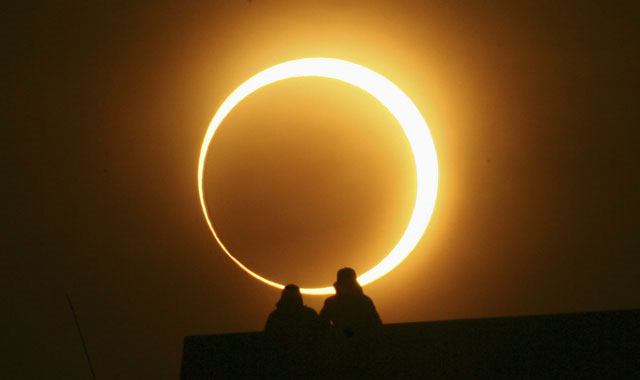Sino-Japanese-Americans will witness an eclipse of the annals
By the time the Sun rises in some parts of China and Japan and at the time of the Sun setting in the West of the United States, people in these places may witness a real solar eclipse, lasting from February 20-21. / 5.
>>>Coming soon see the 'fire ring' surrounding the Sun.
Depending on where people stand in the Sun's path, some may find that the Sun is mostly covered by the Moon, leaving only the bright, shining belt to the outside. Others will see that the Sun has a crescent shape because it is partially covered by the Moon. This phenomenon will last 4-5 minutes.
According to Fred Espenak, a longtime eclipse expert who collaborated with the US Aeronautics and Space Administration (NASA), this will be the first time in 18 years that the eclipse can be seen clearly from the United States.
"The unusual thing about this solar eclipse is that it passes through the American West" - he said - "People always think eclipses are a particularly rare phenomenon, in fact each year has two eclipses. But every year, the annular eclipse can only be seen in a small part of the Earth's surface. "

The eclipse of the annals
The path of the annular eclipse will spread over an area ranging from 240-300km across the East Asia, North Pacific and West America. The solar eclipse will begin at sunrise in South China at 22:06 GMT Sunday, or early Monday local time, and will quickly move east to the coast. South Japan.
According to NASA, with more than 10 million people living in urban areas, the annular eclipse will last 5 minutes, starting at 2232 GMT. Then, the shadow will begin the journey of 7,000km across the Pacific Ocean, lasting about 2 hours, passing through the Aleutian Islands of Alaska. Japan reached the coast of Oregon and California at 1:23 pm GMT on Monday and people in the states of Nevada, Utah, New Mexico, Arizona and Texas will be able to see this phenomenon.
The east coast of the US will not see the eclipse, because at that time, the sun had set.
"The Nevada desert area, southern Utah and northern Arizona may be the best places to witness a solar eclipse, if these places have clear sky conditions and the eclipse process takes place at low points in the sky. , in a majestic setting, "said Alan MacRobert, editor of the Sky & Telescope magazine.
According to cloud data, China and Japan will have no luck witnessing an eclipse, as their sky will be gray.
"Unfortunately, this is the rainy season and the weather will not be favorable in South China," MacRobert told AFP, but still urged people to closely monitor the weather forecast.
He also reminded people not to look directly at the Sun because their eyes could be permanently damaged. Even wearing sunglasses is not enough to protect the eyes from the sun's rays. Instead, experts say that people should buy specialized solar light lenses to protect their " window of the soul" .
In addition, Espenak suggests that people use binoculars to view the eclipse, by placing the binoculars on a white piece of paper and the tail facing the Sun.
"It is important not to see the Sun through binoculars. With this method, we will see the Sun exaggerated on the carton and the eclipse is taking place , " he said.
Experts say that the next time the Earth will have the opportunity to witness a total solar eclipse, which is much more interesting than an annular solar eclipse, and this phenomenon will occur on August 21, 2017. .
- Where is the best eclipse on March 9 in Vietnam?
- The final total eclipse of the decade in the South American sky
- Reality and myths about solar eclipses
- Admire the first picture of the eclipse of 1851
- See eclipse images taken from satellites
- Partial eclipse across North America
- There will be the longest eclipse of the century!
- Rare real Japanese swept across 3 continents
- 2017 will have the best total solar eclipse of 99 years
- Beam: See a unique solar eclipse around the world
- Eclipse, eclipse appeared in November
- The famous eclipse in history
 Van Allen's belt and evidence that the Apollo 11 mission to the Moon was myth
Van Allen's belt and evidence that the Apollo 11 mission to the Moon was myth The levels of civilization in the universe (Kardashev scale)
The levels of civilization in the universe (Kardashev scale) Today Mars, the sun and the Earth are aligned
Today Mars, the sun and the Earth are aligned The Amazon owner announced a secret plan to build a space base for thousands of people
The Amazon owner announced a secret plan to build a space base for thousands of people